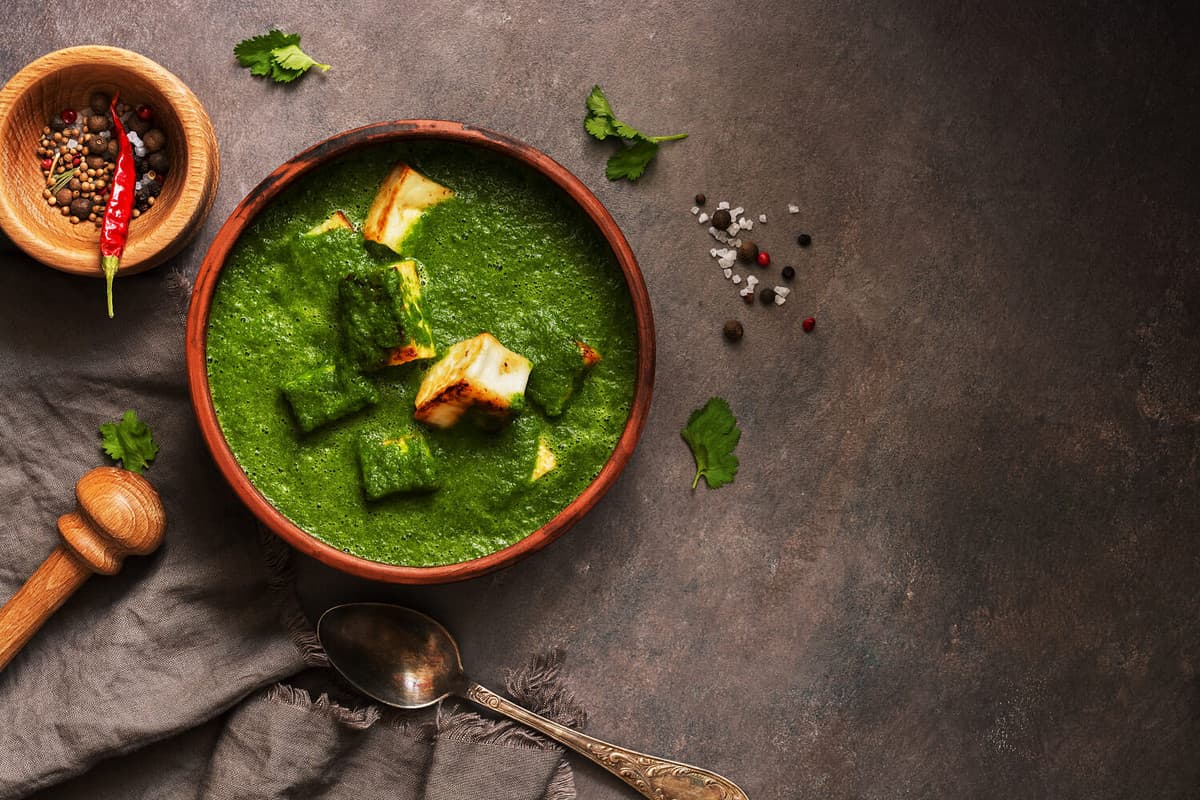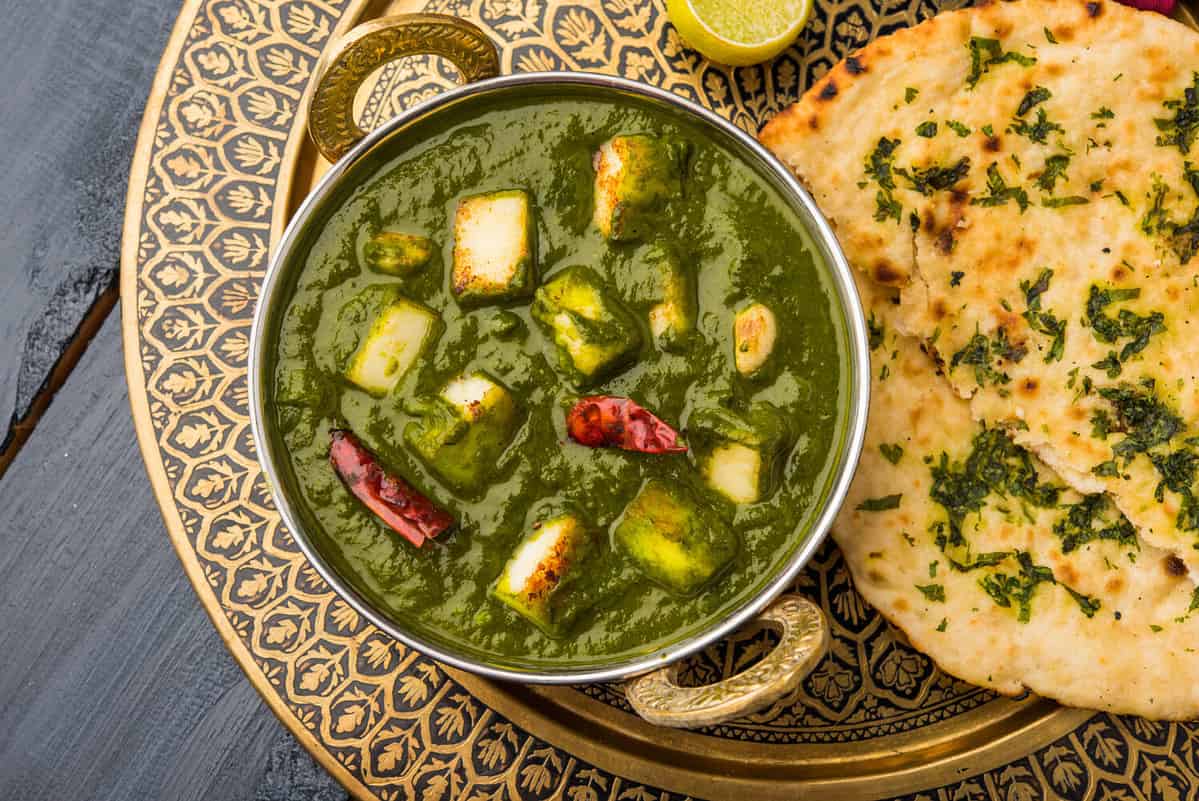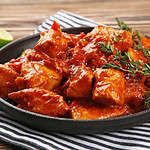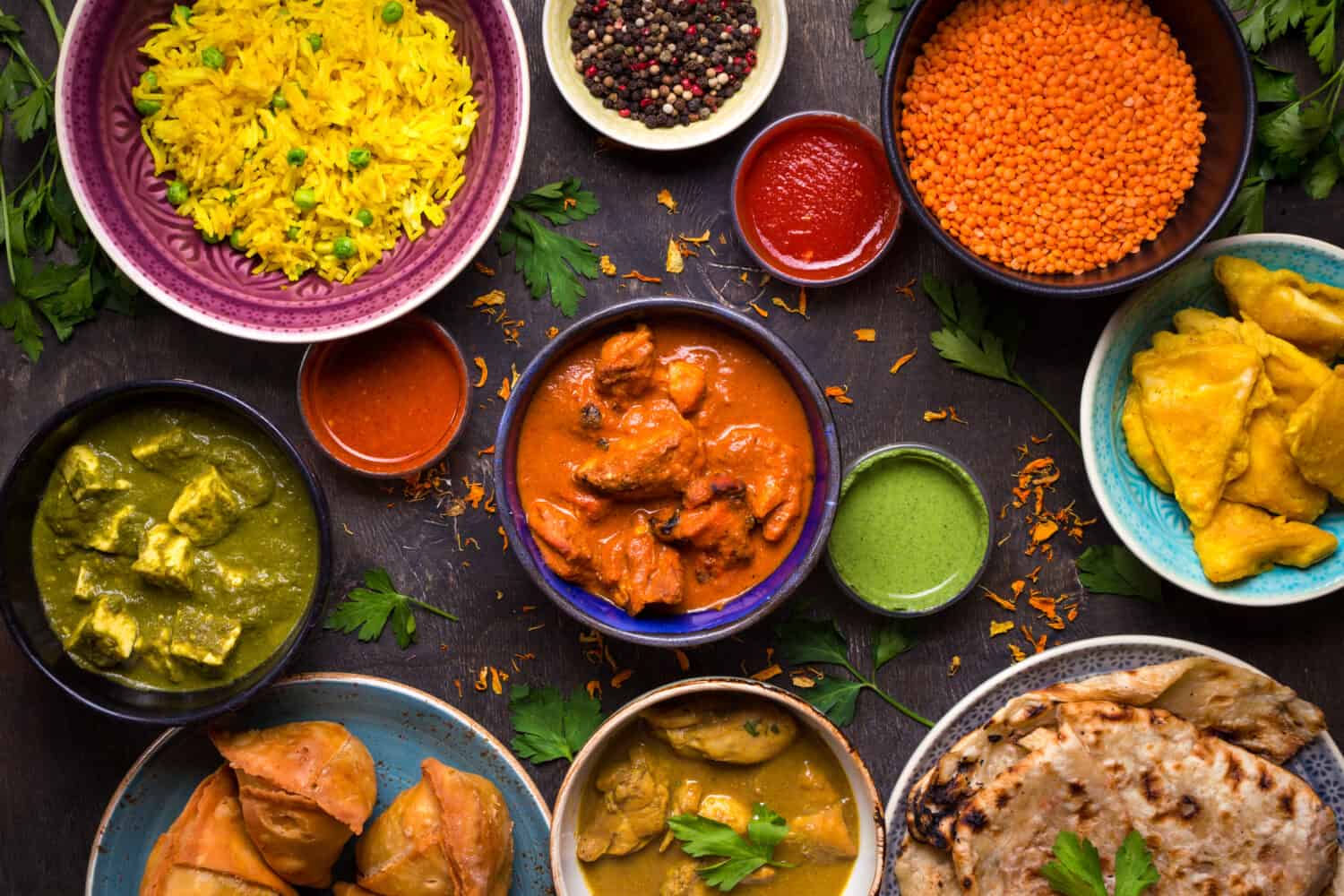Paneer is a popular type of cheese in Indian cuisine you'll find in a variety of recipes. Two of the most common dishes that include this cheese are saag paneer and palak paneer. Although the names of these two dishes are sometimes used interchangeably, there are several differences between saag paneer vs. palak paneer.
The main difference between saag paneer and palak paneer is the ingredients you use when making them. Saag paneer includes a variety of greens, with mustard greens being the most popular choice, while palak only includes spinach leaves. The most common greens for saag paneer are mustard greens. Palak paneer traditionally includes only spinach since palak means spinach in Hindi.
No matter what type of dish you prefer, there are some differences between these two nutritious meals. Keep reading to find out the difference between saag paneer vs. palak paneer as well as where paneer comes from.

©Yulia Gust/Shutterstock.com
Saag Paneer vs. Palak Paneer: What Is the Difference?
If you’re a fan of Indian cuisine, you’re probably familiar with paneer and dishes like saag paneer or palak paneer. Paneer is a type of soft Indian cheese and although there are differences between these two meals, fried paneer is a main ingredient in both recipes.
Determining the difference between saag and palak paneer can be confusing, but there are subtle differences between these two dishes. The main difference between saag paneer and palak is the ingredients you use to make them. Palak means spinach in Hindi, which is a fitting name since spinach is the only vegetable in this dish. On the other hand, saag paneer includes a variety of greens with the most common type being mustard greens.
There is also a difference in their physical appearance due to the different types of greens and the addition of cream to palak paneer. For this reason, saag paneer is much darker. Saag paneer and palak paneer contain similar spices and you can serve either dish with a side of rice, roti, or naan.
No matter which dish you choose, you can find a recipe for making it at home or you can find a nearby Indian restaurant where you can enjoy a delicious meal made with paneer.
Main Differences Between Saag vs Palak
Like many similar dishes, it's common to confuse saag and palak paneer. However, there are several differences between them. Here are the main differences between saag and palak:
- Their ingredients are different
The main difference between these dishes is the ingredients. While you make saag paneer with various greens, palak paneer only contains spinach. - Their appearance is different
The way you make both dishes as well as their ingredients leads to a much darker color in saag paneer. Additionally, palak paneer often includes cream, which lightens the color of it as well. - Palak paneer is a common dish
While it's common to find palak paneer on the menu at an Indian restaurant, you won't see saag paneer as frequently. Since spinach is the only green in palak paneer, saag paneer is common in regions where spinach isn’t easy to find.
What Is Paneer?
If you’re familiar with Indian cuisine, you’re likely familiar with paneer. Paneer is a type of Indian cheese created from a combination of curdled milk and an acid. The curdled milk can be from a cow or a buffalo and the acid often comes from a fruit or vegetable, such as lemon juice.
What distinguishes paneer from other types of cheese is that it’s a soft, unaged cheese. When cooking with paneer, you’ll also notice that it doesn’t melt, which makes it great for frying. The texture of paneer is firm and even though it’s a soft cheese, it doesn’t spread like Brie and other soft cheeses.
When it comes to the flavor of the cheese, paneer isn’t salted like most cheese we’re used to eating in American cuisine. Paneer is a popular ingredient in many Indian dishes, especially because of the prevalence of meat restrictions in Indian culture. 100 grams of paneer can provide you with 21 grams of protein, which is an excellent benefit for those eating a vegetarian diet.
What Is Saag Paneer?
Saag paneer is a delicious Indian dish with plenty of flavor. Although it’s not as popular as palak paneer, it’s still common to see in Indian cuisine, especially in certain regions. Saag paneer hasn’t been around as long as palak paneer, but it’s a good substitute to make when you don’t have spinach on hand.
The star of saag paneer is the paneer itself, also known as Indian cottage cheese. However, unlike cottage cheese, it’s not runny or spreadable like many other soft cheeses.
There are conflicting opinions on what should be included in saag paneer, although there is some agreement that what makes it stand out from palak paneer is the presence of other greens.
While saag can include spinach like palak paneer, it also includes other types of greens such as radish leaves, fenugreek leaves, or mustard greens, which are the most popular kinds found in this dish.
What Is Palak Paneer?
When compared to saag paneer, paneer is similar in many ways, but it also has several differences. The main difference between saag paneer and palak paneer is that palak only has spinach while saag has other types of greens.
You’ll also notice, if you compare the two, that palak paneer is lighter in color. This is partly because of the presence of different greens in saag paneer and partly because palak paneer often includes cream as well, which lightens the color.
In palak paneer, you’ll experience spices such as turmeric powder, chili powder, or coriander. Palak paneer also includes blanched spinach leaves. The process of blanching spinach involves cooking it in boiling water for a short period and then cooling it immediately in ice water. It can also be blanched by cooking it in steam.
The process of blanching the spinach, which doesn’t happen with saag paneer, turns the spinach bright green, which impacts the color of the dish as well.

©StockImageFactory.com/Shutterstock.com
What Can You Substitute for Paneer?
Like many dishes in Indian cuisine, saag paneer and palak paneer are vegetarian. This is perfect for those with meat restrictions. The paneer is a good source of protein and adds to the thickness of the dish. However, since it is a type of cheese, you might wonder if there’s anything you can substitute for paneer, especially if you’re vegan or lactose intolerant.
Unlike most cheeses, paneer doesn’t melt, so it’s challenging to find a non-dairy cheese substitute that can match the texture and consistency. Anything you substitute is going to change the overall flavor and consistency of this dish, but the closest substitute for paneer would be tofu.
The paneer in saag paneer and palak paneer is often fried before adding it to the dish. To achieve this same flavor and texture, you can sear or fry your tofu as well.
Making Saag Paneer or Palak Paneer at Home
If you’re interested in trying one of these two dishes, you can head to a local Indian restaurant or attempt making them at home. The only ingredient that may be tricky to find is the paneer. If you have an Indian market or grocery store, check there first. You can also check in the exotic cheese section of a grocery store or check a health food store near you.
Both saag and palak paneer can be tasty and nutritious meals to make at home. If you’re looking for something comforting on a cool day or when you’re feeling under the weather, test out a recipe for saag or palak paneer. Try this delicious recipe!
Print
Paneer Tikka Masala
- Total Time: 1 hour
Description
For the Paneer Marinade:
- 250g paneer, cubed
- 1/2 cup thick yogurt
- 1 Tablespoon ginger-garlic paste
- 1 Tablespoon Kashmiri red chili powder (or paprika for milder flavor)
- 1 Tablespoon garam masala
- 1 Tablespoon lemon juice
- Salt to taste
- Skewers for grilling (wooden skewers, soaked in water for 30 minutes)
For the Gravy:
- 2 tablespoons ghee or oil
- 1 large onion, finely chopped
- 2 large tomatoes, pureed
- 1 Tablespoon ginger-garlic paste
- 1 teaspoon cumin powder
- 1 teaspoon coriander powder
- 1/2 teaspoon turmeric powder
- 1 teaspoon Kashmiri red chili powder
- 1 teaspoon garam masala
- 1/2 cup heavy cream
- Salt to taste
- Fresh coriander leaves for garnish
Ingredients
For the Paneer Marinade:
In a bowl, mix yogurt, ginger-garlic paste, Kashmiri red chili powder, garam masala, lemon juice, and salt to form the marinade.
Add paneer cubes to the marinade, ensuring they are well-coated. Let it marinate for at least 30 minutes.
Thread the marinated paneer onto skewers.
Grill the paneer skewers until golden brown and slightly charred, either on a grill or in an oven.
For the Gravy:
In a pan, heat ghee or oil. Sauté chopped onions until golden brown.
Add ginger-garlic paste and sauté for another minute.
Add cumin powder, coriander powder, turmeric powder, Kashmiri red chili powder, and garam masala. Cook for 2-3 minutes until the spices release their aroma.
Pour in the tomato puree and cook until the oil starts to separate from the masala.
Add heavy cream, salt, and grilled paneer. Simmer for 5-7 minutes until the gravy thickens.
Garnish with fresh coriander leaves.
Nutrition
- Calories: 400
- Sugar: 6 g
- Sodium: 600 mg
- Fat: 30 g
- Carbohydrates: 15 g
- Fiber: 15 g
- Protein: 15 g
- Cholesterol: 80 mg
The image featured at the top of this post is ©Elena Eryomenko/Shutterstock.com.

